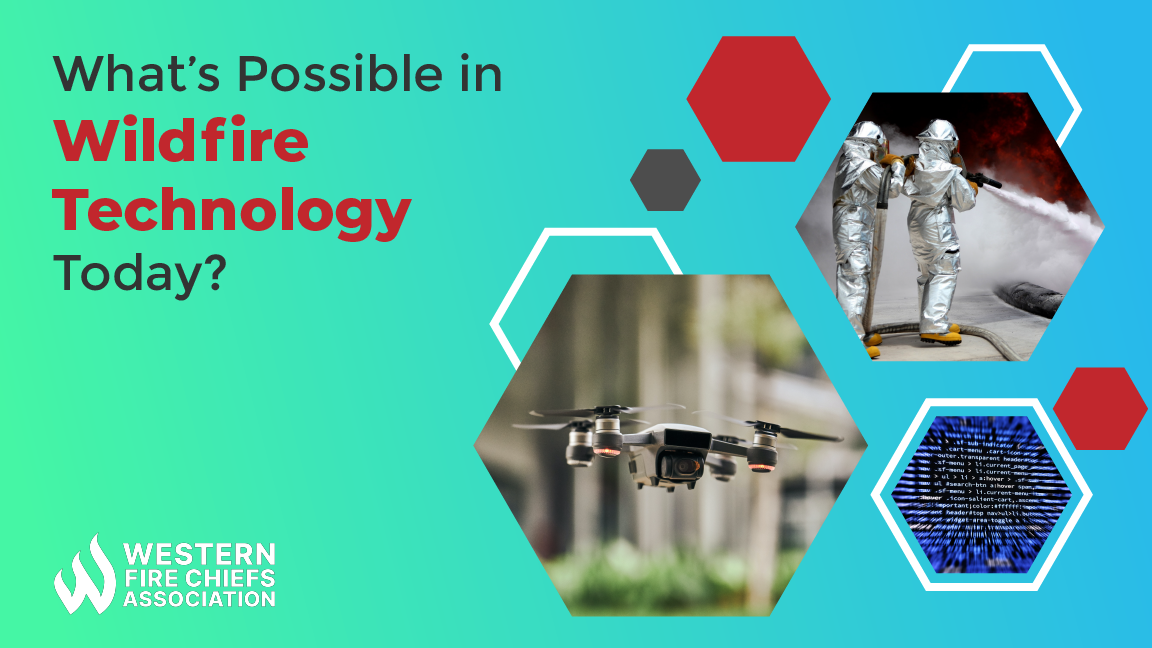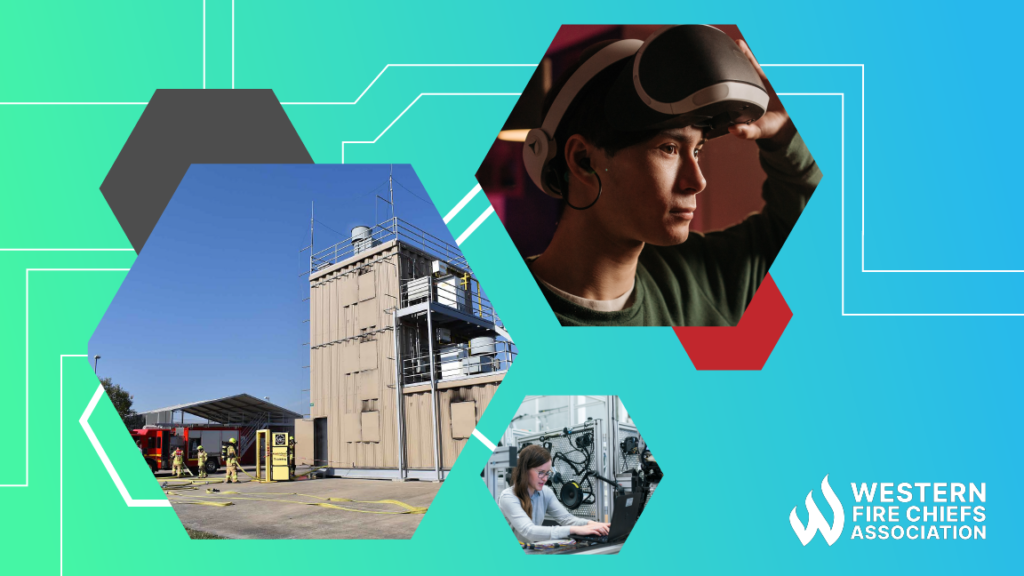Fire Pit Safety Tips
Stay safe around the campfire with tips from the Western Fire Chiefs Association. Learn essential precautions and practices for a worry-free outdoor campfire.
With the increase of fire activity across the country, new technology to fight wildfires is helping transform the industry. Learn more from the experts at WFCA.
Published:March 30, 2023
Edited:March 1, 2024

With the increase of fire activity across the country, new technology to fight wildfires is helping transform the industry. Learn more from the experts at WFCA.
Technology that helps firefighters respond more safely to wildland fires has seen huge development in recent years. Some new wildfire technology includes improved cameras, drones, robots, AI implemented to address wildfire concerns, and virtual reality training.
Fire seasons are growing in duration and intensity throughout the world. When fires go unnoticed for long periods of time, they become a greater danger to the surrounding area as they build beyond what firefighters can easily contain. The expanding wildland urban interface (WUI) also brings human beings, homes, and communities closer to areas that are higher risk for wildfires. There is always a need to improve tech for fast fire detection, thoughtful response planning, and firefighting practices that save lives.
One tactic to fight wildfires is by using aircraft. However, this is dangerous for both pilots and firefighters. According to the National Institute for Occupational Safety and Health, 26% of all wildland firefighter fatalities are related to aviation.1 Aerial firefighting must balance the health risks of smoke inhalation and poor visibility, and flights are limited by high winds and air turbulence caused by radiant heat from the fire.
Instead of risking pilot and firefighter lives in the air, states are beginning to use drones; unmanned aerial systems that can be piloted remotely or with autonomous flight software. Firefighting drones designed to survey the area are equipped with high definition, infrared, and thermal imaging cameras. They can fly at night, when manned aircraft are grounded.2 Drones are used to spot dangers on the ground, resources that firefighters can use, and plot terrain maps to help direct ground teams of firefighters.3 Their sensors are strong enough to help identify spot fires, which occur when wildfire embers are blown by the wind and start a new fire in a nearby location. Some specialized drones are able to identify a 2-inch spot fire from half a mile away.2
Along with surveying, drones can set prescribed burns in the path of approaching wildfires. With an attachment, drones can drop hundreds of ping-pong-ball-sized incendiary devices to start purposeful fires that reduce fuel ahead of the larger fire.4 Using drones for this is safer than using helicopters, and firefighters can precisely pre-program the drone’s route.4
Drones are also utilized in reforestation efforts after a wildfire. They can drop seeds in areas that would be difficult for ground crews to reach. Seed deployment can also be preprogrammed, based on terrain maps of the area, so reforestation can be done automatically.5
There has been a growing interest in applying artificial intelligence (AI) and machine learning to disaster management. Machine learning is a subfield of AI and both are ways that computers can learn and provide insights without being specifically programmed to perform functions.6 There is great potential for firefighting teams to use AI to assess historical and current wildfire data when considering fire response.
AI algorithms can forecast fire behavior, such as FireMap, an AI predictive mapping platform developed by WIFIRE Lab. It takes in satellite, ground sensor, camera, and aerial infrared data and accounts for weather, topography, drought conditions, and other factors to build out the projected trajectory of a wildfire.4
In addition to predicting wildfire paths, universities and tech companies are starting to consider how to use AI for wildfire prevention, detection, and response management. Machine learning software can take in massive amounts of data, including imaging technology and weather data, social media posts and trends, sensor networks, and smoke detection from cameras and satellites.7 For example, Santa Fe-based Descartes Lab uses AI software to review images from two United States-owned weather satellites every ten minutes. The AI looks for smoke or changes in thermal data that could mean a fire, then reviews these potential hotspots to determine how likely it is that a fire has started. If the AI algorithms determine the risk is high, the system delivers directions to fire personnel. Between 2019-21, Descartes Lab’s AI system spotted over 6,000 fires in California and has identified fires as small as ten acres.4
In home fire situations, AI can also help firefighters find and rescue victims more quickly. Researchers from the National Robotarium in Edinburgh, Scotland, have developed an AI helmet attachment that uses artificial intelligence (AI) to help firefighters find and rescue victims faster. The hardware has sensors, thermal cameras, and radar technology to help firefighters navigate smoky environments. The AI maps the surroundings, scanning a room in 5-10 seconds and ensuring firefighters can rescue victims more quickly.8
Wildfires often start in remote locations, which make it difficult to report fires. Installing cameras in wildland is one way to detect fires, but network service can be unreliable. One solution is to install cameras on towers, which give a wide view, and to mount microwave dishes and other instruments alongside the cameras to relay data quickly.9
Pan-Tilt-Zoom (PTZ) fire cameras and their accessory instruments help identify or confirm fire locations and magnitudes, monitor fire growth, contribute to planning approaches by mapping the area, and monitor to ensure fires are contained and suppressed. Placing PTZ cameras on “towers of opportunity,” such as telecommunications towers, allows 100+ fire cameras to be installed in months.10 The data is part of a network of cameras, which ensures that if a dish goes down, it does not cause the entire network to fail.9
Fires pose a huge danger to human life, but robots can directly fight fires in ways that would put humans at risk. With heat-sensing cameras and on-board water or other fire retardants, these machines can navigate steep terrain or enter burning homes to fight fires directly. Most of the robots currently in use are controlled remotely by firefighters, but researchers are beginning to combine AI with robots that enables the robots to make decisions about the best firefighting strategies on their own.11
Robots are also able to carry equipment or evacuate people from an area, without risking firefighters’ safety in dangerous conditions. They can deliver situation assessments with thermal and infrared cameras on the ground or in the air.12 The major barrier to using robots to fight fires is the prohibitive cost. Scientists are working to develop ways to reduce the price of firefighting robots, which may cost hundreds of thousands of dollars.11

Live training for firefighters is essential to teach and test their skills and decision-making in the field. Training can still be dangerous, and some training exercises have resulted in firefighter injury or death. The U.S. Fire Administration (USFA) reported that, in 2008-19, 110 firefighters were killed during training.13
In 2020, the USFA recommended using virtual reality (VR) simulations for firefighter training. Virtual reality employs computer-generated simulations, near-eye displays, and pose tracking to allow a person to interact with a three-dimensional image or space. Using VR for firefighter training conserves resources that would be used up in training, allows for training to happen anytime and anywhere, delivers scenarios that can be repeated or simulated with multiple responses to the same situation, and takes place in a safe training environment. Instructors are able to pause and rewind to go over an experience again, which gives firefighting trainees more insights into situations they might encounter in the real world.14
Firefighter VR focuses on specific job practices, such as fire behavior, forcible entry, and vent-enter-isolate-search (VEIS) practices. The equipment can be relatively low-cost, but the quality of the experience can improve with more haptic technology, which senses tactile information such as vibrations, physical contact, and force feedback. Using a haptic firehose while experiencing a VR simulation enhances the training, and there are also VR trainings for the public as well as firefighters that explore how to use a fire extinguisher.15
Mixing virtual reality with physical experiences can also take a simulation even further. An Australia-based training company, FLAIM Systems, has combined VR with tools that include a suit that can reach almost 200 degrees Fahrenheit.13 Training experiences can be made more realistic and give firefighters a sense of what to expect in emergencies.
There are even more exciting fire response solutions that are possible by combining tech. For example, the company Pano networks tower mounted cameras, satellite data, field sensors, and other data with AI-supported rapid data analysis to quickly identify and plan wildfire response plans.16 Wildfire technology is always evolving to expand safe and creative responses to fire emergencies.
Stay safe around the campfire with tips from the Western Fire Chiefs Association. Learn essential precautions and practices for a worry-free outdoor campfire.
Discover essential firework safety tips to ensure a dazzling display without accidents. Learn how to celebrate responsibly with expert guidance from WFCA.
Explore the role of AI in wildfire prediction with guidance from the WFCA. Learn how advanced algorithms and data analytics enhance early detection and response.